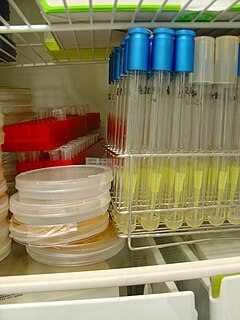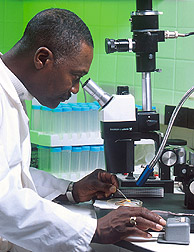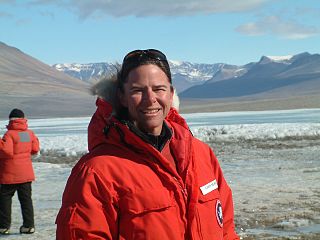Related Research Articles

Drug resistance is the reduction in effectiveness of a medication such as an antimicrobial or an antineoplastic in treating a disease or condition. The term is used in the context of resistance that pathogens or cancers have "acquired", that is, resistance has evolved. Antimicrobial resistance and antineoplastic resistance challenge clinical care and drive research. When an organism is resistant to more than one drug, it is said to be multidrug-resistant.

A microbiological culture, or microbial culture, is a method of multiplying microbial organisms by letting them reproduce in predetermined culture medium under controlled laboratory conditions. Microbial cultures are foundational and basic diagnostic methods used as a research tool in molecular biology.
An antimicrobial is an agent that kills microorganisms or stops their growth. Antimicrobial medicines can be grouped according to the microorganisms they act primarily against. For example, antibiotics are used against bacteria, and antifungals are used against fungi. They can also be classified according to their function. Agents that kill microbes are microbicides, while those that merely inhibit their growth are called bacteriostatic agents. The use of antimicrobial medicines to treat infection is known as antimicrobial chemotherapy, while the use of antimicrobial medicines to prevent infection is known as antimicrobial prophylaxis.

Stanley "Stan" Falkow was an American microbiologist and a professor of microbiology at Georgetown University, University of Washington, and Stanford University School of Medicine. Falkow is known as the father of the field of molecular microbial pathogenesis. He formulated molecular Koch's postulates, which have guided the study of the microbial determinants of infectious diseases since the late 1980s. Falkow spent over 50 years uncovering molecular mechanisms of how bacteria cause disease and how to disarm them. Falkow also was one of the first scientists to investigate antimicrobial resistance, and presented his research extensively to scientific, government, and lay audiences explaining the spread of resistance from one organism to another, now known as horizontal gene transfer, and the implications of this phenomenon on our ability to combat infections in the future.
Microbial intelligence is the intelligence shown by microorganisms. The concept encompasses complex adaptive behavior shown by single cells, and altruistic or cooperative behavior in populations of like or unlike cells mediated by chemical signalling that induces physiological or behavioral changes in cells and influences colony structures.
In microbiology, the minimum inhibitory concentration (MIC) is the lowest concentration of a chemical, usually a drug, which prevents visible growth of a bacterium or bacteria. MIC depends on the microorganism, the affected human being, and the antibiotic itself. It is often expressed in micrograms per milliliter (μg/mL) or milligrams per liter (mg/L).

Medical microbiology, the large subset of microbiology that is applied to medicine, is a branch of medical science concerned with the prevention, diagnosis and treatment of infectious diseases. In addition, this field of science studies various clinical applications of microbes for the improvement of health. There are four kinds of microorganisms that cause infectious disease: bacteria, fungi, parasites and viruses, and one type of infectious protein called prion.

Daan Frenkel is a Dutch computational physicist in the Department of Chemistry at the University of Cambridge.
Alejandro Jenkins is a Costa Rican theoretical physicist. He is currently a professor at the University of Costa Rica and a member of Costa Rica's National Academy of Sciences. He has worked on applications of quantum field theory to particle physics and cosmology, as well as on self-oscillating dynamical systems and quantum thermodynamics.

Altechromone A is a chromone derivative. To date, it has been isolated from plant families such as Polygonaceae, Lamiaceae, Fabaceae, and Hypericaceae.

Enzybiotics are an experimental antibacterial therapy first described by Nelson, Loomis, and Fischetti. The term is derived from a combination of the words “enzyme” and “antibiotics.” Enzymes have been extensively utilized for their antibacterial and antimicrobial properties. Proteolytic enzymes called endolysins have demonstrated particular effectiveness in combating a range of bacteria and are the basis for enzybiotic research. Endolysins are derived from bacteriophages and are highly efficient at lysing bacterial cells. Enzybiotics are being researched largely to address the issue of antibiotic resistance, which has allowed for the proliferation of drug-resistant pathogens posing great risk to animal and human health across the globe.

Helen Frances Gleeson OBE FInstP is a British physicist who specialises in soft matter and liquid crystals. She is Cavendish Professor and former Head of the School of Physics at the University of Leeds.
Raymond Ethan Goldstein FRS FInstP is Schlumberger Professor of Complex Physical Systems in the Department of Applied Mathematics and Theoretical Physics (DAMTP) at the University of Cambridge and a Fellow of Churchill College, Cambridge.
Collective motion is defined as the spontaneous emergence of ordered movement in a system consisting of many self-propelled agents. It can be observed in everyday life, for example in flocks of birds, schools of fish, herds of animals and also in crowds and car traffic. It also appears at the microscopic level: in colonies of bacteria, motility assays and artificial self-propelled particles. The scientific community is trying to understand the universality of this phenomenon. In particular it is intensively investigated in statistical physics and in the field of active matter. Experiments on animals, biological and synthesized self-propelled particles, simulations and theories are conducted in parallel to study these phenomena. One of the most famous models that describes such behavior is the Vicsek model introduced by Tamás Vicsek et al. in 1995.

Alison Murray is an American microbial ecologist and Antarctic researcher, best known for studying the diversity, ecology and biogeography of Antarctic marine plankton dynamics of the plankton over the annual cycle; and her work demonstrating the existence of microbial life within an ice-sealed Antarctic lake. She studies how microorganisms persist and function in extremely cold and harsh environments, including those that lack oxygen and biological sources of energy.
Surajit Sen is a physicist who works on theoretical and computational problems in non-equilibrium statistical physics and in nonlinear dynamics of many body systems. He holds a Ph.D in physics from The University of Georgia (1990) where he studied with M. Howard Lee. He is also interested in applying physics to study problems of relevance in a societal context. He is a professor of physics at the State University of New York, Buffalo.

Maria Cristina Marchetti is an Italian-born, American theoretical physicist specializing in statistical physics and condensed matter physics. In 2019, she received the Leo P. Kadanoff Prize of the American Physical Society. She held the William R. Kenan, Jr. Distinguished Professorship of Physics at Syracuse University, where she was the director of the Soft and Living Matter program, and chaired the department 2007-2010. She is currently Professor of Physics at the University of California, Santa Barbara.

Abigail A. Salyers was a microbiologist whose research focused on bacteria in the intestinal tract contributing to better understanding of antibiotic resistance and mobile genetic elements. She was awarded numerous teaching awards, an honorary degree from ETH Zurich and was a past president of the American Society for Microbiology.
Jennifer B. H. Martiny is an American ecologist who is a Professor at the University of California, Irvine. Her research considers microbial diversity in marine and terrestrial ecosystems. In 2020 she was elected a Fellow of the American Association for the Advancement of Science.
Katelin Schutz is an American particle physicist known for using cosmological observations to study dark sectors, that is new particles and forces that interact weakly with the visible world. She is a NASA Einstein Fellow and Pappalardo Fellow in the MIT Department of Physics.
References
- ↑ Rosalind J. Allen publications from Europe PubMed Central
- 1 2 3 4 5 6 "Rosalind Allen". youngacademyofscotland.org.uk. Retrieved 2019-01-20.
- ↑ "2016 Careers Event". SUPA. Retrieved 2019-01-20.
- ↑ Allen, Rosalind (2003). Electrostatic interactions in confined geometries. copac.jisc.ac.uk (PhD thesis). University of Cambridge. OCLC 879389634. EThOS uk.bl.ethos.595460.
- ↑ Piasecki, Jaroslaw; Allen, Rosalind J.; Hansen, Jean-Pierre (2004). "Kinetic models of ion transport through a nanopore". Physical Review E. 70 (2): 021105. arXiv: cond-mat/0403219 . Bibcode:2004PhRvE..70b1105P. doi:10.1103/PhysRevE.70.021105. PMID 15447477. S2CID 2602284.
- ↑ Allen, Rosalind J.; Frenkel, Daan; ten Wolde, Pieter Rein (2006). "Simulating rare events in equilibrium or nonequilibrium stochastic systems". The Journal of Chemical Physics. 124 (2): 024102. arXiv: cond-mat/0509499 . Bibcode:2006JChPh.124b4102A. doi:10.1063/1.2140273. ISSN 0021-9606. PMID 16422566. S2CID 9409013.

- 1 2 "Forward Flux Sampling". amolf.nl. Retrieved 2019-01-20.
- ↑ "Rare events in biochemical networks". amolf.nl. Retrieved 2019-01-20.
- ↑ Allen, Rosalind J.; Warren, Patrick B.; ten Wolde, Pieter Rein (2005). "Sampling Rare Switching Events in Biochemical Networks". Physical Review Letters. 94 (1): 018104. arXiv: q-bio/0406006 . Bibcode:2005PhRvL..94a8104A. doi:10.1103/PhysRevLett.94.018104. ISSN 0031-9007. PMID 15698138. S2CID 7998065.

- ↑ "Numerical Mathematics/Scientific Computing". numerik.mi.fu-berlin.de. Retrieved 2019-01-20.
- 1 2 "Prof. Rosalind Allen - Antimicrobial resistance: how can a physicist help?". Media Hopper Create - The University of Edinburgh Media Platform. Retrieved 2019-01-20.
- 1 2 3 4 5 Anon (2009). "Dr Rosalind Allen: Research Fellow". royalsociety.org. London: Royal Society. Archived from the original on 2019-01-21. Retrieved 2019-01-20.
- ↑ Free, Andrew; Allen, Rosalind J.; Michael E. Cates; Spears, Bryan M.; Strathdee, Fiona; Pagaling, Eulyn (2014). "Community history affects the predictability of microbial ecosystem development". The ISME Journal. 8 (1): 19–30. doi:10.1038/ismej.2013.150. ISSN 1751-7370. PMC 3869022 . PMID 23985743.
- ↑ Lloyd, Diarmuid P.; Allen, Rosalind J. (2015). "Competition for space during bacterial colonization of a surface". Journal of the Royal Society Interface. 12 (110): 399–404. doi: 10.1098/rsif.2015.0608 . ISSN 1742-5689. PMC 4614474 . PMID 333814.
- ↑ "Rosalind Allen's webpage - Metabolism". ph.ed.ac.uk. Retrieved 2019-01-20.
- ↑ "Rideal Lecture 2017: preview". soci.org. Retrieved 2019-01-20.
- ↑ "US Army research office grant". edinburghcomplexfluids.com. The Edinburgh Complex Fluids Partnership. Retrieved 2019-01-20.
- ↑ "Inaugural Lecture: Antimicrobial resistance: how can a physicist help? | School of Physics and Astronomy". ph.ed.ac.uk. Retrieved 2019-01-20.
- ↑ "Rosalind Allen's webpage - Bacterial response to antibiotics". ph.ed.ac.uk. Retrieved 2019-01-20.
- 1 2 3 Greulich, Philip; Waclaw, Bartłomiej; Allen, Rosalind J. (2012). "Mutational Pathway Determines Whether Drug Gradients Accelerate Evolution of Drug-Resistant Cells". Physical Review Letters. 109 (8): 088101. arXiv: 1202.5431 . Bibcode:2012PhRvL.109h8101G. doi:10.1103/PhysRevLett.109.088101. PMID 23002776. S2CID 610511.
- ↑ Allen, Rosalind J; Waclaw, Bartlomiej (2018). "Bacterial growth: a statistical physicist's guide". Reports on Progress in Physics. 82 (1): 016601. arXiv: 1812.04435 . doi:10.1088/1361-6633/aae546. ISSN 0034-4885. PMC 6330087 . PMID 30270850.
- ↑ "RSC Harrison-Meldola Prize Previous Winners". rsc.org. Retrieved 2019-01-20.
- 1 2 Anon (2016). "Dr Rosalind Allen: Parent-carer scientist". royalsociety.org. London: Royal Society. Archived from the original on 2020-10-20. Retrieved 2019-01-20.